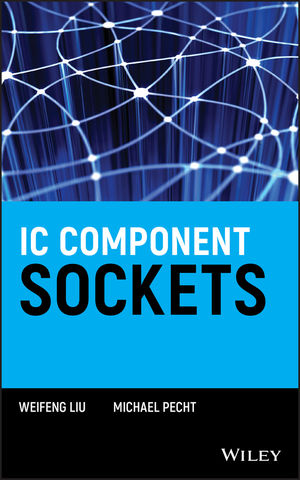IC Component SocketsISBN: 978-0-471-46050-3
Hardcover
232 pages
March 2004
 This is a Print-on-Demand title. It will be printed specifically to fill your order. Please allow an additional 10-15 days delivery time. The book is not returnable.
|
||||||
Preface xi
1 IC Component Socket Overview 1
1.1 Levels of Interconnections 1
1.2 Component-to-Board Interconnection 2
1.3 Classification of Component Sockets 3
1.4 Structure of IC Component Sockets 4
1.4.1 Socket Housing 5
1.4.2 Socket Contact 8
1.4.3 Socket Actuation 8
1.4.4 Heat Sink 9
1.4.5 Socket Polarization 10
1.5 Socket Function 10
1.6 Socket Assembly 11
1.7 Benefits of Using IC Component Sockets 11
1.7.1 Component Test and Burn-in 11
1.7.2 Component Upgrade and Exchange 12
1.7.3 Flexibility in IC Design and Assembly and Supply Chain Management 13
1.7.4 Use of Sockets to Avoid Soldering 13
1.7.5 Component Replacement and Repair 14
1.7.6 Cost Savings 14
1.8 Challenges Facing IC Component Sockets 15
1.8.1 Extra Signal Path 15
1.8.2 Increased Assembly Area 15
1.8.3 Compatibility with Fine-Pitch Applications 15
1.8.4 Reliability 16
1.9 IC Component Socket Market 17
1.10 Summary and Future Directions 18
References 18
2 Component Socket Properties 21
2.1 Socket Contact 21
2.1.1 Insertion and Extraction Force 21
2.1.2 Contact Retention 24
2.1.3 Contact Force and Resistance 25
2.1.4 Contact Deflection and Resistance 27
2.1.5 Contact Wipe 29
2.1.6 Current Rating 31
2.1.7 Capacitance and Inductance 32
2.1.8 Bandpass and Bandwidth 35
2.2 Socket Housing 37
2.2.1 Electrical Properties 37
2.2.2 Mechanical Properties 39
2.2.3 Temperature Rating 41
2.2.4 Flammability 42
2.3 Summary 43
References 43
3 IC Component Socket Materials 45
3.1 Socket Housing 45
3.1.1 Polymer Fundamentals 45
3.1.2 Thermoplastics 47
3.1.3 Thermosetting Polymers 50
3.1.4 Additives 52
3.1.5 Housing Manufacturing 53
3.2 Socket Contact 53
3.2.1 Copper Alloys 54
3.2.2 Nickel Alloys 59
3.2.3 Conductive Elastomers 60
3.2.4 Contact Manufacturing 61
3.3 Socket Contact Plating 64
3.3.1 Noble Metal Plating 65
3.3.2 Non-Noble Metal Plating 69
3.3.3 Underplate 70
3.3.4 Plating Process 71
3.4 Summary 74
References 74
4 Component Sockets for PTH Packages 76
4.1 DIP Sockets 76
4.1.1 DIP Socket Designs 76
4.1.2 Dual-Beam Contact Design 78
4.1.3 Single-Beam Contact Design 79
4.1.4 Multiple-Finger Contact Design 80
4.1.5 Low-Force Contact Design 81
4.1.6 ZIF Contact Design 81
4.1.7 Insertion and Extraction Tools 81
4.2 PGA Sockets 82
4.2.1 PGA Socket Designs 82
4.2.2 Dual-Beam Contact Design 85
4.2.3 Multiple-Finger Contact Design 85
4.2.4 Fuzz Button Contact Design 85
4.2.5 ZIF Contact Design 86
4.2.6 Insertion and Extraction Tools 86
4.3 Summary 87
References 87
5 Component Sockets for J-Leaded Packages 88
5.1 Socket Designs 88
5.1.1 Single-Pinch Contact Design 89
5.1.2 Dual-Pinch Contact Design 90
5.1.3 Side-Contact Design 90
5.1.4 Nested-Contact Design 90
5.1.5 ZIF Contact Design 91
5.1.6 Insertion and Extraction Tools 91
5.2 Summary 92
References 93
6 Component Sockets for Gull-wing Packages 94
6.1 Socket Designs 94
6.1.1 Shoulder Contact Design 94
6.1.2 Tip Contact Design 95
6.1.3 Foot Contact Design 96
6.1.4 Ankle Contact Design 97
6.1.5 Dual-Pinch Contact Design 98
6.1.6 Insertion and Extraction Tools 98
6.2 Summary 99
References 99
7 Component Sockets for BGA Packages 100
7.1 Socket Designs 100
7.1.1 Solder Ball Bottom Contact Design 102
7.1.2 Single-Sided Contact Design 105
7.1.3 Double-Sided Contact Design 106
7.1.4 Four-Point Crown Contact Design 108
7.2 Summary 109
References 109
8 Component Sockets for LGA Packages 110
8.1 LGA Socket Designs 112
8.1.1 Metallic Spring Design 114
8.1.2 Pogo Pin Socket Design 123
8.1.3 Wire-Button Contact Design 125
8.1.4 Conductive Elastomer Design 125
8.2 Comparison of Contact Reliability 134
8.3 Future Challenges for LGA Socket Design 135
8.4 Summary 135
References 136
9 Failure Modes and Mechanisms 138
9.1 Dry Oxidation 140
9.2 Pore Corrosion 141
9.3 Creep Corrosion 142
9.4 Fretting Corrosion 143
9.5 Galvanic Corrosion 145
9.6 Stress Corrosion 145
9.7 Electrochemical Migration 145
9.8 Intermetallic Formation 145
9.9 Stress Relaxation 146
9.10 Creep 147
9.11 Fracture and Fatigue 148
9.12 Friction Polymerization 148
9.13 Whisker Growth 149
9.14 Fungus Growth 150
9.15 Contact Wear 151
9.16 Outgassing 152
9.17 Leakage Current and Dielectric Breakdown 152
9.18 Swelling 153
9.19 Summary 153
References 154
10 Socket Testing and Qualification 158
10.1 Accelerated Testing 158
10.2 Environmental Classifications 161
10.3 Test Conditions 162
10.3.1 Preconditioning 162
10.3.2 Shock and Vibration 162
10.3.3 Thermal Aging 164
10.3.4 Temperature Cycling 164
10.3.5 Thermal Cycling with Humidity 165
10.3.6 Mixed Flowing Gas Tests 165
10.3.7 Particulate Tests 168
10.4 Test Sequencing 170
10.5 Four-Wire versus Two-Wire Measurement 170
10.6 Periodic and Continuous Monitoring 171
10.7 Virtual Reliability Assessment 172
10.8 Socket Qualification 173
10.9 Summary 174
References 174
11 Reliability Assessment 176
11.1 Contact Resistance Theory 176
11.2 Contact Reliability Theory 179
11.3 Intermittences 182
11.4 Socket Reliability Prediction 183
11.4.1 IEEE Reliability Prediction Standard 1413 183
11.4.2 Guidebook for IEEE Standard 1413 185
11.5 Achieving Socket Reliability 185
11.6 Summary 190
References 190
12 Standards and Specifications 192
12.1 Standards and Specifications 192
12.2 Obtaining Documents 199
Appendix A Terms and Definitions 201
Appendix B Socket Manufacturers 206
Index 215



